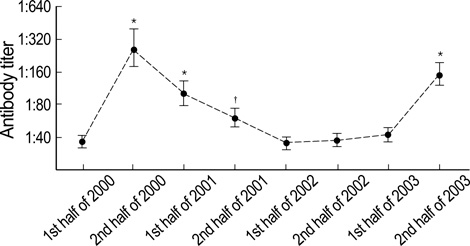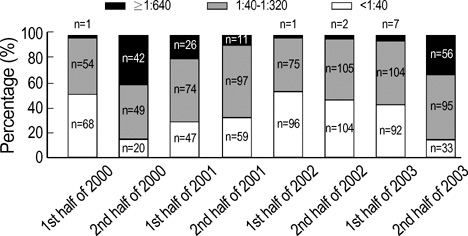J Korean Med Sci.
2005 Aug;20(4):542-547. 10.3346/jkms.2005.20.4.542.
Distributions of Antibody Titers to Mycoplasma pneumoniae in Korean Children in 2000-2003
- Affiliations
-
- 1Department of Pediatrics, Dongguk University Interna-tional Hospital, Ilsan, Seoul, Korea.
- 2Department of Pediatrics, Korea University Anam Hospital, Seoul, Korea.
- 3Department of Pediatrics, College of Medicine, Seoul National University, Seoul, Korea. kohyy@plaza.snu.ac.kr
- 4Department of Pediatrics, Korea University Guro Hospital, Seoul, Korea.
- KMID: 1712730
- DOI: http://doi.org/10.3346/jkms.2005.20.4.542
Abstract
- The aim of study was to describe Mycoplasma pneumoniae epidemics in a hospital-based population. Special attention was paid to the relationship between antibody titer to M. pneumoniae and sex, age, and atopy. During the eight 6-month periods between January 2000 and December 2003, serum samples were obtained from 1,319 Korean children who presented with respiratory symptoms, and were examined for antibodies to M. pneumoniae using the indirect particle agglutination test. Geometric mean antibody titers peaked in the second half of 2000 and then decreased gradually, a second peak occurred in the second half of 2003. Likewise, the frequency of high antibody titers (>or=1:640) also peaked during these two periods. Antibody titers in children aged 0-3 yr were lower than in older children during both peak periods and for 2 yr after the first peak. Sex and atopy had no effect on antibody titers. During the years 2000-2003, geometric mean antibody titers and the frequencies of high antibody titers varied with time. These changes suggest a cyclic pattern of M. pneumoniae infection, with two epidemic peaks separated by 3 yr.
Keyword
MeSH Terms
-
Adolescent
Age Distribution
Antibodies, Bacterial/*blood
Child
Child, Preschool
Disease Outbreaks/statistics & numerical data
Female
Humans
Infant
Infant, Newborn
Korea/epidemiology
Male
Mycoplasma pneumoniae/*immunology
Pneumonia, Mycoplasma/*blood/epidemiology/immunology
Research Support, Non-U.S. Gov't
Sex Distribution
Time Factors
Figure
Cited by 3 articles
-
Evaluation of Four Commercial IgG- and IgM-specific Enzyme Immunoassays for Detecting Mycoplasma pneumoniae Antibody: Comparison with Particle Agglutination Assay
Soo Jin Yoo, Hye-Jeon Oh, Bo-Moon Shin
J Korean Med Sci. 2007;22(5):795-801. doi: 10.3346/jkms.2007.22.5.795.Indirect Particle Agglutination Antibody Testing for Early Diagnosis of Mycoplasma pneumoniae pneumonia in Children
Jin Soo Kim, Jeong Hee Ko, Sung Hee Oh
Korean J Pediatr Infect Dis. 2013;20(2):71-80. doi: 10.14776/kjpid.2013.20.2.71.Clinical issues regarding increased macrolide-resistant Mycoplasma pneumoniae in children
Jinho Yu
Allergy Asthma Respir Dis. 2017;5(1):1-2. doi: 10.4168/aard.2017.5.1.1.
Reference
-
1. Atmar RL, Greenberg SB. Pneumonia caused by Mycoplasma pneumoniae and the TWAR agent. Semin Respir Infect. 1989. 4:19–31.2. Lind K, Benzon MW, Jensen JS, Clyde WA Jr. A seroepidemiological study of Mycoplasma pneumoniae infections in Denmark over the 50-year period 1946-1995. Eur J Epidemiol. 1997. 13:581–586.3. Foy HM, Kenny GE, Cooney MK, Allan ID. Long-term epidemiology of infections with Mycoplasma pneumoniae. J Infect Dis. 1979. 139:681–687.
Article4. Ito I, Ishida T, Osawa M, Arita M, Hashimoto T, Hongo T, Mishima M. Culturally verified Mycoplasma pneumoniae pneumonia in Japan: a long-term observation from 1979-99. Epidemiol Infect. 2001. 127:365–367.
Article5. Foy HM, Kenny GE, McMahan R, Mansy AM, Grayston JT. Mycoplasma pneumoniae pneumonia in an urban area. Five years of surveillance. JAMA. 1970. 214:1666–1672.
Article6. Joosting AC, Harwin RM, Coppin A, Battaglia P, van der Hoef P. A serological investigation of Mycoplasma pneumoniae infection on the Witwatersrand. S Afr Med J. 1976. 50:2134–2135.7. Kang KS, Woo H. Pattern of occurrence of Mycoplasma pneumoniae pneumonia in admitted children: southern central Korea, from 1989 to 2002. J Korean Pediatr Soc. 2003. 46:474–479.8. Park HY, Woo CW, Choung JT, Son CS, Tockgo YC. Trend of the Mycoplasma pneumonia: during recent 9 years period. Pediatr Allergy Respir Dis. 1995. 5:49–59.9. Yoo HS, Kang HY, Jeoung BJ, Kim KE, Lee KY. A clinical study of Mycoplasma pneumoniae pneumonia. Pediatr Allergy Respir Dis. 1995. 5:112–122.10. Hong JY, Nah SY, Nam SG, Choi EH, Park JY, Lee HJ. Occurrence of Mycoplasma pneumoniae pneumonia in Seoul, Korea, from 1986 to 1995. J Korean Pediatr Soc. 1997. 40:607–613.11. Waris ME, Toikka P, Saarinen T, Nikkari S, Meurman O, Vainionpaa R, Mertsola J, Ruuskanen O. Diagnosis of Mycoplasma pneumoniae pneumonia in children. J Clin Microbiol. 1998. 36:3155–3159.12. Waites KB. New concepts of Mycoplasma pneumoniae infections in children. Pediatr Pulmonol. 2003. 36:267–278.13. Daxboeck F, Krause R, Wenisch C. Laboratory diagnosis of Mycoplasma pneumoniae infection. Clin Microbiol Infect. 2003. 9:263–273.
Article14. Rastawicki W, Kaluzewski S, Jagielski M. Occurrence of serologically verified Mycoplasma pneumoniae infections in Poland in 1970-1995. Eur J Epidemiol. 1998. 14:37–40.15. Ponka A, Ukkonen P. Age-related prevalence of complement-fixing antibody to Mycoplasma pneumoniae during an 8-year period. J Clin Microbiol. 1983. 17:571–575.16. Bosnak M, Dikici B, Bosnak V, Dogru O, Ozkan I, Ceylan A, Haspolat K. Prevalence of Mycoplasma pneumoniae in children in Diyarbakir, the south-east of Turkey. Pediatr Int. 2002. 44:510–512.
Article17. Barker CE, Sillis M, Wreghitt TG. Evaluation of Serodia Myco II particle agglutination test for detecting Mycoplasma pneumoniae antibody: comparison with mu-capture ELISA and indirect immunofluorescence. J Clin Pathol. 1990. 43:163–165.
Article18. Choi SK, Jung JA, Kim KH, Kim GH. Study of seroprevalence of antimycoplasma antibody in healthy children and its diagnostic value. J Korean Pediatr Soc. 1998. 41:489–497.19. Host A, Andrae S, Charkin S, Diaz-Vazquez C, Dreborg S, Eigenmann PA, Friedrichs F, Grinsted P, Lack G, Meylan G, Miglioranzi P, Muraro A, Nieto A, Niggemann B, Pascual C, Pouech MG, Rance F, Rietschel E, Wickman M. Allergy testing in children: why, who, when and how? Allergy. 2003. 58:559–569.
Article20. Wittig HJ, Belloit J, De Fillippi I, Royal G. Age-related serum immunoglobulin E levels in healthy subjects and in patients with allergic disease. J Allergy Clin Immunol. 1980. 66:305–313.
Article21. Tang ML, Coleman J, Kemp AS. Interleukin-4 and interferon-gamma production in atopic and non-atopic children with asthma. Clin Exp Allergy. 1995. 25:515–521.22. Foy HM, Kenny GE, Cooney MK, Allan ID, van Belle G. Naturally acquired immunity to pneumonia due to Mycoplasma pneumoniae. J Infect Dis. 1983. 147:967–973.
Article23. Foy HM, Kenny GE, Seri R, Ochs HD, Allan ID. Second attacks of pneumonia due to Mycoplasma pneumoniae. J Infect Dis. 1977. 135:673–677.
Article24. Biberfeld G. Antibody responses in Mycoplasma pneumoniae infection in relation to serum immunogloblins, especially IgM. Acta Pathol Microbiol Scand Sect B. 1971. 79:620–634.25. Nakamura S, Ebisawa I, Kitamoto O, Sato T. Persistence of serum antibody following Mycoplasma pneumoniae infection. Am Rev Respir Dis. 1970. 101:620–622.26. Broughton RA. Infections due to Mycoplasma pneumoniae in childhood. Pediatr Infect Dis. 1986. 5:71–85.
Article27. Lind K, Bentzon MW. Ten and a half years seroepidemiology of Mycoplasma pneumoniae infection in Denmark. Epidemiol Infect. 1991. 107:189–199.28. Layani-Milon MP, Gras I, Valette M, Luciani J, Stagnara J, Aymard M, Lina B. Incidence of upper respiratory tract Mycoplasma pneumoniae infections among outpatients in Rhone-Alpes, France, during five successive winter periods. J Clin Microbiol. 1999. 37:1721–1726.29. Fernald GW, Collier AM, Clyde WA Jr. Respiratory infections due to Mycoplasma pneumoniae in infants and children. Pediatrics. 1975. 55:327–335.30. Brunner H, Horswood RL, Chanock RM. More sensitive methods for detection of antibody to Mycoplasma pneumoniae. J Infect Dis. 1973. 127:Suppl. S52–S55.
Article31. Dallo SF, Baseman JB. Intracellular DNA replication and long-term survival of pathogenic mycoplasmas. Microb Pathog. 2000. 29:301–309.
Article32. Radisic M, Torn A, Gutierrez P, Defranchi HA, Pardo P. Severe acute lung injury caused by Mycoplasma pneumoniae: potential role for steroid pulses in treatment. Clin Infect Dis. 2000. 31:1507–1511.33. Holtmann H, Shemer-Avni Y, Wessel K, Sarov I, Wallach D. Inhibition of growth of Chlamydia trachomatis by tumor necrosis factor is accompanied by increased prostaglandin synthesis. Infect Immun. 1990. 58:3168–3172.
Article34. Williams DM, Magee DM, Bonewald LF, Smith JG, Bleicker CA, Byrne GI, Schachter J. A role in vivo for tumor necrosis factor alpha in host defense against Chlamydia trachomatis. Infect Immun. 1990. 58:1572–1576.
Article35. Sher A, Coffman RL. Regulation of immunity to parasites by T cells and T cell-derived cytokines. Annu Rev Immunol. 1992. 10:385–409.
Article36. Kaufman SH. Immunity to intracellular bacteria. Annu Rev Immunol. 1993. 11:129–163.37. Ferrari M, Poli A, Olivieri M, Verlato G, Tardivo S, Nicolis M, Campello C. Respiratory symptoms, asthma, atopy and Chlamydia pneumoniae IgG antibodies in a general population sample of young adults. Infection. 2002. 30:203–207.
Article
- Full Text Links
- Actions
-
Cited
- CITED
-
- Close
- Share
- Similar articles
-
- Diagnostic Significance of Cold Agglutinin and Antimycoplasma Antibody for Mycoplasma pneumoniae Infection
- Clinical Study of Interrelationship Between Cold Agglutinin Titers and Indirect Hemagglutination Titers in Children with Mycoplasma Pneumoniae Pneumonia During Recent 3 Years
- A Study of Antibody Conversion Rate During a Mycoplasma pneumoniae Epidemic Period(the Second Half of 2003)
- A clinical study of mycoplasma pneumonia in children during recent 5 years
- Clinical Findings of Mycoplasma Pneumonia in Children, from 1998 to 2003



